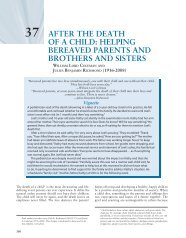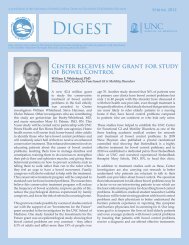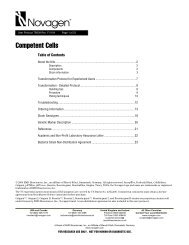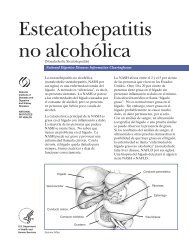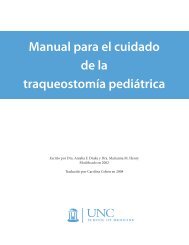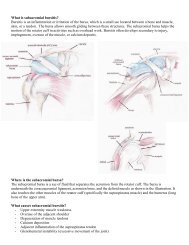Affinity Chromatography Handbook
Affinity Chromatography Handbook
Affinity Chromatography Handbook
You also want an ePaper? Increase the reach of your titles
YUMPU automatically turns print PDFs into web optimized ePapers that Google loves.
30<br />
Performing a separation<br />
Column: HiTrap Protein G HP, 1 ml or 5 ml<br />
Recommended flow rates: 1 ml/min (1 ml column) or 5 ml/min (5 ml column)<br />
Binding buffer: 0.02 M sodium phosphate, pH 7.0<br />
Elution buffer: 0.1 M glycine-HCl, pH 2.7<br />
Neutralization buffer: 1 M Tris-HCl, pH 9.0<br />
Centrifuge samples (10 000 g for 10 minutes) to remove cells and debris. Filter through a<br />
0.45 µm filter. If required, adjust sample conditions to the pH and ionic strength of the<br />
binding buffer either by buffer exchange on a desalting column or by dilution and pH<br />
adjustment (see page 133).<br />
1. Equilibrate column with 5 column volumes of binding buffer.<br />
2. Apply sample.<br />
3. Wash with 5–10 column volumes of the binding buffer to remove impurities and unbound material. Continue<br />
until no protein is detected in the eluent (determined by UV absorbance at 280 nm).<br />
4. Elute with 5 column volumes of elution buffer*.<br />
5. Immediately re-equilibrate with 5–10 column volumes of binding buffer.<br />
*Since elution conditions are quite harsh, it is recommended to collect fractions into neutralization buffer (60 µl – 200 µl<br />
1 M Tris-HCl, pH 9.0 per ml fraction), so that the final pH of the fractions will be approximately neutral.<br />
IgGs from most species and subclasses bind to protein G at near physiological pH and ionic<br />
strength. For the optimum binding conditions for IgG from a particular species, it is worth<br />
consulting the most recent literature. Avoid excessive washing if the interaction between the<br />
protein and the ligand is weak, since this may decrease the yield.<br />
Most immunoglobulin species do not elute from Protein G Sepharose until pH 2.7 or less.<br />
If biological activity of the antibody or antibody fragment is lost due to the low pH<br />
required for elution, try Protein A Sepharose: the elution pH may be less harsh.<br />
Desalt and/or transfer purified IgG fractions to a suitable buffer using a desalting column<br />
(see page 133).<br />
Reuse of Protein G Sepharose depends on the nature of the sample and should only be<br />
considered when processing identical samples to avoid cross-contamination.<br />
To increase capacity, connect several HiTrap Protein G HP columns (1 ml or 5 ml) in series.<br />
HiTrap columns can be used with a syringe, a peristaltic pump or connected to a liquid<br />
chromatography system, such as ÄKTAprime. For greater capacity pack a larger column<br />
with Protein G Sepharose 4 Fast Flow (see Appendix 3).








